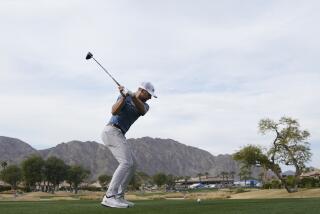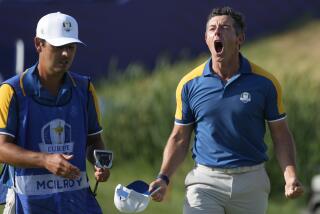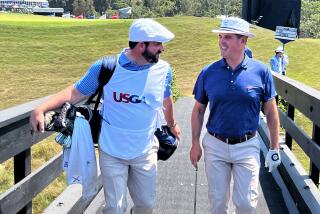TOM KITE
- Share via
AUSTIN, Texas — He stood with the family in front of seats high above the 40-yard line in Memorial Stadium, right hand up, index and small fingers pointed at the sky, exhorting the ‘Horns to hook UCLA.
Tom Kite was where he has spent countless Saturdays since his folks had Texas season tickets in his youth, but football and golf were colliding in his consciousness.
He’s never far from Longhorn football and hasn’t been far from the Ryder Cup since he was named captain of the U.S. team for this weekend’s matches in Spain.
“We had a deal here today, right before the game,” he said just before UCLA hooked his ‘Horns, 66-3.
“We had a little golf team reunion, guys from the ‘30s, ‘40s, ‘50s, right up to the present team. Obviously . . . any time you’ve got a bunch of golfers, they all want to talk about Ryder Cup. I never got a chance to eat because everybody wants to talk about Ryder Cup.”
There’s no escape, and there has been little respite for Kite for the last 18 months, save for the time he has spent between gallery ropes at PGA Tour events.
He has weathered it all, somehow playing 20 tournaments this year and standing 28th on the money list with $627,222, all the while answering questions: Who will be the captain’s picks, what will the pairings be, what about Seve, who, what, where, when, why?
The captaincy was bestowed on him for his play in 25 years on the PGA Tour and, mainly, for winning the 1992 U.S. Open, for the PGA of America wants its captain to have a major win.
But honor has its price.
“I had no clue,” he says. “Lanny [Wadkins] and Tom [Watson, the previous captains] had both told me it would take an awful lot of work and an awful lot of time.
“I guess the thing that I underestimated badly was the amount. I knew there was a lot of interest and a lot of attention, but I underestimated the amount of time it would take with you guys [reporters]. The demands there--again, it’s not tough stuff, it’s stuff that I enjoy talking about. [But] I’ve been living it now for the last year and a half, and there’s just an awful lot of it. There’s an awful lot of interest in the Ryder Cup and there’s an awful lot of guys in the media covering it.”
He has approached his duties in the same low-key manner in which he has approached a game he has played well enough to win more than $10 million. He has played golf, and he has worked golf.
Take the makeup of the two-man teams that will play in alternate-shot and better-ball matches. Beyond all else, beyond the trappings of uniforms and transportation and appearances and journalists’ questions, pairings are most important. They can be products of a captain’s imagination, but they are better products when there is less imagination.
“I’ve had conversations with every member on the team,” Kite says. “I’m kind of getting their feel on what they think and who they think would be good teams. . . .
“It makes sense to pair them with guys they feel comfortable with, and I need to know who they want to play with, and who they don’t want to play with, and who they’ve had some success with and who they think would make good teams.
“It makes a lot of sense to pair them with guys that they feel comfortable with, as opposed to guys they have no track record with.”
His approach is the result of his experience in seven Ryder Cup competitions. Kite holds the Cup record for the highest winning score in an individual match, having beaten Howard Clark, 8 and 7, in 1989; and he shares the team winning margin with Hale Irwin. The two beat Ken Brown and Des Smyth in 1979, 7 and 6.
“I’ve been the victim of some pairings that I didn’t understand, and sometimes it worked out, but more times than not it didn’t,” Kite says. “Also, I’ve been the recipient of some captains who sought the advice of some of the players and they came up with some good pairings.”
His pool of players is pleasing, with more Ryder Cup experience than he had envisioned only two months ago. The Ryder Cup points list yielded 10 players he wanted for the team, and he was able to add experience in captain’s choices Fred Couples and Lee Janzen.
“With the possible exception of me--and I’ll qualify that with a little chuckle--there’s not a player that I would want on my team that’s not on my team,” says Kite, who would like to be a playing captain but finished 19th on the points list.
The work, of course, is not over.
Where once there was excitement, now there is nervousness, but without a real outlet.
“As a player you can do something about it,” he says. “The nervousness will be different, and I don’t know how it will manifest itself because I’ve never done this before.
“So I don’t know how I will respond. I think I will do well. I have a lot of confidence in my ability. I’ve done my homework. I know what to do. Now it’s just a question of doing it.”
And there will be pressure in the on-the-spot decisions necessary to bring the Ryder Cup back to the U.S. after two years in Europe.
In Spain, eight players will play in each of the four team rounds. Four will watch, most of them disappointed.
“There’ll be a couple of guys--and I don’t know who they will be--who won’t be on top of their game at the matches,” Kite says. “Just like any week, you’re not going to have all 12 of those guys hitting on all cylinders. So that’s just something we’ll have to evaluate at the time. But . . . I don’t feel like I have any player on the team that I have to shy away from, that I have to work around.”
And then there is Seve Ballesteros, the European captain called by Paul Azinger, a frequent victim, “the king of gamesmanship.”
What will he pull?
“I know there are certain things that he wants to do,” says Kite, who played Ballesteros to a draw in their only individual Ryder Cup matchup, in 1985 at the Belfry, and who is 2-4 in team matches, mostly when Ballesteros was paired with his favorite Cup partner, Jose Maria Olazabal.
“He wants to win the matches. Gamesmanship is part of it. I don’t have any problem with that. There’s not going to be any unsportsmanlike stuff. Seve and I have a great relationship. He wants to win. I want to win. And we’re going to do everything we can to win.
“Nothing that I don’t expect there. We’ll discuss it a little bit with the players so that they understand it and are prepared. But no, I don’t expect any problems at all.”
It has been a good run for Kite. “I’ve had an absolute ball with it,” he says. “I’ve built up great relationships with a lot of the players out there, and [with] a lot of young players that I wouldn’t have had the opportunity to get to know as well as I have. And that relationship is going to continue to grow throughout the matches, and hopefully beyond that.”
And beyond that is a return to Texas football, but with the knowledge that he still will be asked to explain how the U.S. hooked--or was hooked by--Europe in the Ryder Cup.
(BEGIN TEXT OF INFOBOX / INFOGRAPHIC)
Tom Kite Profile
* Age: 47.
* Residence: Austin, Texas.
* Career victories: 21 (19 on PGA Tour).
* Major title: 1992 U.S. Open.
* Ryder Cups: 7.
* Ryder Cup record: 15-9-4.
More to Read
Go beyond the scoreboard
Get the latest on L.A.'s teams in the daily Sports Report newsletter.
You may occasionally receive promotional content from the Los Angeles Times.










